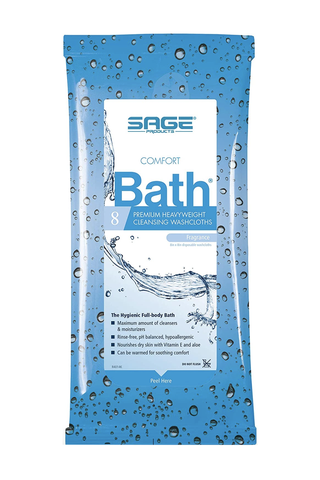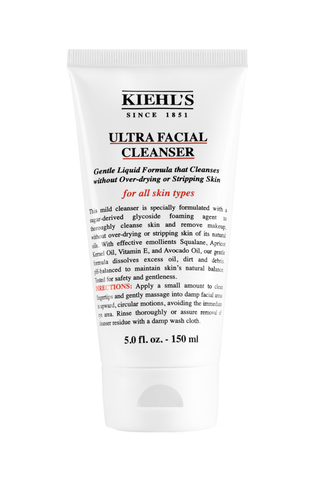
Since its inception, NASA has selected 350 people to train as astronaut candidates. Yet as of April 2020, only 16 percent of astronauts throughout history have been women. And only 14 percent of them have actually flown into space. We're making progress, though—NASA’s most recent graduating class, including Jennifer Sidey-Gibbons from the Canadian Space Agency (CSA), had more women than any other in history; and Christina Koch and Jessica Meir conducted the first all-female spacewalk just last year.
Still, there's little information on what life is actually like for women in orbit. Yes, you get stellar views and your skin looks way younger (it’s true!), but how do you wash your hair? What happens to your period? Can you bring makeup? Marie Claire enlisted the help of Serena Auñón-Chancellor, a member of NASA’s 2009 astronaut class who traveled on board the International Space Station (ISS) in 2018, and Dr. Jennifer Fogarty, chief scientist of the NASA Human Research Program, to break it all down.
For more information on a specific topic, click below.
- The Beauty of Space
- Menstrual Cycle in Spaceflight
- Working Out in Zero Gravity
- Sex in Space
- How to Handle Stress and Mental Health
The Beauty of Space
How Do You Wash Your Face in Space?
Water is precious on Earth, but it’s even more sacred in space. Eighty percent of water on board the ISS is recycled, which means every drop counts. “You take little bits [of water] in your hand and kind of gracefully move them over your face just to wash it. In space, there’s a strong surface tension so water forms into huge blocks—you can still spread it all over your face, but it splatters in every direction, so you can’t use as much,” says Auñón-Chancellor. “Then I would use a little bit of soap and keep my face clean that way. We don't really have anything exfoliating up there.”
Christina Koch and Jessica Meir brush their teeth on board the International Space Station.
What About Brushing Your Teeth?
Brushing your teeth on the ISS is basically the same as brushing your teeth on Earth...without the running water. Astronauts keep all of their hygienic products in a cosmetic bag that attaches to a wall with velcro. After they connect a plastic bag to a potable water dispenser and fill it with recycled, purified water, they squeeze a few drops on to the toothbrush and start brushing their teeth like normal. There aren't any sinks on board (washing your face and brushing your teeth happen in the middle of the hygienic station), so astronauts have to—gasp!—swallow their toothpaste. To clean the toothbrush, they'll grab the bag of water and rinse it.
Are Skincare Routines a Thing?
Just like everyone’s skincare routine is different on Earth, the same goes for space. “I’m from Houston and our humidity is fairly high, which is what I’m used to,” Auñón-Chancellor explains. “Before experiencing space, I thought it was a much drier atmosphere than it actually is. I don’t have too much trouble with dry skin so I keep [my routine] really simple [in space]. I use a cleansing soap and a moisturizer. Every product we bring, even our toothpaste, must be cleared by NASA’s safety team. They evaluate specific chemicals in all products to make sure they’re safe according to the ISS standards, which limits what I bring.”
Shop Similar Space-Friendly Beauty Products
Can You Shower in Space?
Astronauts don’t have the luxury of running water. (Cherish your showers, ladies and gents!). “Since there are no showers, we use packaged hygienic towels that are pre-laden with soap and add hot water to them,” Auñón-Chancellor shares. “It’s like a sponge bath but with a towel. The towel has a slightly rough surface, which offers a little bit of exfoliation for our body and face.”
Stay In The Know
Marie Claire email subscribers get intel on fashion and beauty trends, hot-off-the-press celebrity news, and more. Sign up here.
Does That Make Shaving Harder?
“Yes, the way you shave your body changes since there's no running water,” she explains. “Basically, I take a generic razor and unscented shaving cream or lotion and spread that on my skin. Each time I glide the razor up to shave, I wipe off the remnants with a disposable wipe or towel. I’m very conservative with the amount of shaving cream I use. I’m always thinking, How much shaving cream do I have left? How many razor blades do I have? I definitely don’t shave as often in space as I do on Earth.”
Jessica Meir washes her hair on board the International Space Station.
How Do You Wash Your Hair In Space?
The art of hair-washing in space is quite complex and unbelievable. “Hair is a lot more difficult to take care of in space,” Auñón-Chancellor admits. “On Earth, I wash my hair every three or four days but it takes so much more time in orbit because of the way water acts. Honestly, the way I learned to wash my hair was from Karen Nyberg’s YouTube video. It’s not very glamorous. I start by squeezing a bag of water along my scalp. The water just sits there so I use a brush to rake it through. Next, I use a no-rinse shampoo—the same kind you can find in nursing homes or hospitals. It suds up a bit and then I add more water. It takes about 20 to 25 minutes, compared to my usual three-minute routine on Earth.”
Auñón-Chancellor, who identifies as Hispanic, has thick curls. When it comes to natural hair, only three Black women—Mae Jemison, Joan Higginbotham, and Stephanie Wilson—have traveled to space, so there's limited information on how to care for this hair texture in space. Past photos show that these women of color wore their natural hair both straightened and curly.
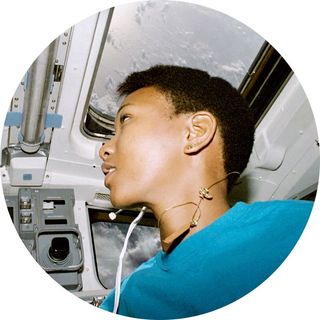
Mae Jemison, the first African-American woman in space, is pictured on board the International Space Station wearing her short natural hair.
Can You Blow-Dry Your Hair?
There’s no such thing as a blow-out beyond Earth. However, there is a hack to create your own makeshift Dry Bar. Aside from generating oxygen and removing carbon dioxide from the atmosphere, the ventilation system aboard the ISS actively circulates air through a series of fans and pumps, helping it flow throughout the station.
“My hair normally takes about 15 minutes to air-dry,” Auñón-Chancellor says. “In space, however, I have to make a concerted effort. Ventilation runs in the International Space Station where the air comes out. I float up there and stick my hair in front of it for a while, which helps [it] air-dry faster. Otherwise, the water clings to my hair and face, since there's no convection in space, and it easily takes my hair three to four hours to dry.”
As for how she styles her hair once it is dry: “For safety reasons, I usually wear it pulled back in a ponytail. Velcro is everywhere on the station and you don't want to get your head caught on anything.”
Do Astronauts Have a Daily Makeup Routine?
Just like their skincare routine, the amount of makeup astronauts use varies based on personal preference. “I wear very little makeup in space even though on Earth I wear it daily,” says Auñón-Chancellor. “I feel like I don’t have to because my skin just looks so youthful and beautiful. I usually bring eyeliner, eyeshadow, and maybe an eyebrow pencil, but I found that it’s almost more trouble than it's worth to put it on in space. Other female astronauts wear makeup daily, though.”
Are Acne Flare-Ups More Common in Space?
Fact: Any type of change in climate puts stress on the skin. If a cross-country flight leaves you with surprise pimples, imagine what a rocket would do! “A few of my crew members have had issues with acne in orbit,” Auñón-Chancellor says. “I hypothesized that because our skincare routine does differ in orbit compared to the Earth’s orbit, it could be that more oil and grease is building up on the skin.”
How Does Space Impact the Skin’s Aging Process?
There’s a special magic about space that slows down the skin’s aging process or, at least, looks like it does.
“I swear my skin looks younger in space because there’s a massive fluid shift that occurs in orbit,” Auñón-Chancellor reveals. “On Earth, the fluid in your blood vessels are distributed equally throughout the body. Once you get into space, that all shifts towards your head because there’s no gravity. My face certainly looks a little puffier for the first few weeks, then it tends to tone down after a while. After that, all my wrinkles go away and I look younger. When I do video conferences with people on Earth, they even comment on my skin looking younger.”
Menstrual Cycle in Spaceflight
What Happens to Your Period in Space?
NASA lets astronauts choose whether or not they want to stop their menstrual cycle before entering space to avoid potential side effects, like cramps, that might interrupt spaceflight routine. Before spaceflight, they have a discussion with the flight surgeon and some of the consultants who work with crew members to weigh options, like an oral contraceptive or hormonal replacement. If they choose to continue their menstrual cycle, NASA provides them with the feminine hygiene products that they choose.
“For the most part, I think the menstrual cycle works just as it works here on Earth,” explains Auñón-Chancellor. “The body follows the same clock, and it just seems to know. But I've always been happy with the fact that NASA has given women that choice. They're supported medically either way.”
But Wait, How Do You Use the Bathroom?
Managing a menstrual cycle in orbit is very doable—the tough part is actually going to the bathroom. Solid or liquid waste is released in a series of vacuum tubes that’s not exactly well-designed for women. The waste gets sucked into a vacuum and packed into a vehicle called the Progress. When the vehicle comes back to Earth, it burns up all of the waste.
“The adapter [you go to the bathroom in] is really designed for male genitalia,” explains Dr. Fogarty. “They have something very prominent to connect to, whereas for women, it's going to be a lot more challenging because of our anatomy for the vacuum tube to interface with the body. So when you confound it by having a menstrual cycle, where you could have partial liquid and partial solid waste, the woman has to plan things out differently. The system isn't really designed to manage it. We’ve worked to do some redesign over the years to make it more acceptable to the female astronauts, knowing that it wasn't really designed with them in mind.”
She continues, “If you're a first time flyer—like a lot of our women are right now, because we have more women than ever in the astronaut club—on the ground you could think one option would be your preference, but you don't know until you get there. You may want a backup opportunity to say, Okay, that didn't work. I want to use pads instead of tampons or vice versa. The female astronauts pass on a lot of information to each other about how to make it work for them.”
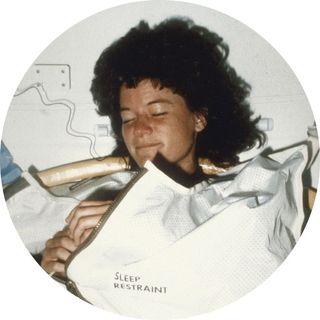
Sally Ride, the first American woman in space, sleeps soundly. Astronauts follow a 24-hour day, just like the rest of us on earth.
Is Your “Internal Clock” Still the Same?
Yes, your "internal clock" should remain the same in space. The crew operates within a 24-hour day, so there shouldn't be a difference between the frequency of a woman’s periods in space and on Earth. If a person had irregular cycles, there hasn’t been any evidence that suggested it was due to spaceflight.
“Astronauts do maintain a pretty regular circadian rhythm. The sun rises and sets every 40 minutes, but we control the inside lighting so that people are very much driven to a 24-hour day,” says Dr. Forgarty. “Just like with our electronic devices, you should have less blue light later in the day and not be staring at computer screens unless it's on night mode or you’re wearing blue light–blocking glasses. Blue light stimulates your brain and can throw you off.”
Is Fertility a Discussion?
“Fertility is something that's important to [NASA], and they've actually made accommodations for female astronauts when it comes to medical care,” explains Auñón-Chancellor. “When women come into the [agency], they tend to be anywhere from their early 30s to their mid 30s or even late 30s. Those are obviously personal discussions they have with the [agency], but we can support it either way, depending on which way a woman would like to go. It's something that's part of every discussion that a female astronaut has with their flight surgeon.”
Working Out in Zero Gravity
How Intense Is an Astronaut's Exercise Routine?
If you think going to the gym for 30 minutes a day is tough, try being an astronaut. It takes incredible strength, both physically and mentally, to do their jobs. Before astronauts are even assigned a mission, specialists called ASCRs (Astronaut, Strength, Conditioning, and Rehabilitation) work with them at the Johnson Space Center in Houston, Texas, to develop strength and conditioning routines and help prepare them for launch.
How Often Do Astronauts Work Out?
Once astronauts are on their mission, they’re expected to exercise for an average of two-and-a-half hours per day to avoid muscle atrophy (the process of muscles weakening or deteriorating as a result of lack of exercise) and to prevent weakening bones that may lead to osteoporosis (a disease that results from the density and quality of bone being reduced due to the lack of gravity). About an hour-and-a-half is dedicated to anaerobic or strength training and an hour of aerobic training, which involves either use of the treadmill or a cycle odometer. (FYI, Auñón-Chancellor wears the same shoes to lift weights and run in space as she does on Earth.)
Christina Koch and Jessica Meir do three different types of workouts on board the International Space Station.
What Types of Workouts Do Astronauts Perform?
NASA has developed special equipment to help astronauts achieve the best workout while aboard the ISS. The devices, described below, are attached to computers that track body mass, heart rate, and the general type of workout the astronaut is doing.
- Weightlifting: The ARED (Advanced Resistive Exercise Device) machine is specially designed to deal with microgravity. It uses a vacuum cylinder that creates a simulated weight so the object actually feels heavy (because of, you know, the whole no gravity thing). This allows astronauts to do squats, bench presses, and deadlifts with up to 600 pounds. Doing these types of workouts are crucial to shortening the recovery period for astronauts once they’re back on Earth.
- Cardio: The COLBERT (Combined Operational Load Bearing External Resistance Treadmill) machine is similar to an Earth-based treadmill. Except in space, you have to be strapped to the machine, wearing a harness clipped down with chains and bungee cords, which keeps astronauts from floating off the treadmill. Astronauts run 30–40 minutes per day, switching from sprints to intervals to long-distance running. There’s also a machine called the CEVIS (Cycle Ergometer with Vibration Isolations and Stabilization System), which focuses on the legs. Astronauts stand while using this bike (there’s no seat) and have to be strapped in by a belt at their hips to keep them down. They’re also strapped in by their feet via special custom biking shoes. It’s similar to a SoulCycle class—except you can just float away when you’ve had enough of your workout.
Since there is no body weight in space, once a month the crew receives a measurement from the Russian-built Body Mass Measurement Device (BMMD). Results are sent down to Earth so doctors can make sure that astronauts are not losing or gaining too much weight. Weight loss is often attributed to loss in bone density, which is not a good sign. Based on this information, astronauts will coordinate with their assigned ASCR to craft a plan to best support their needs and limitations while in space.
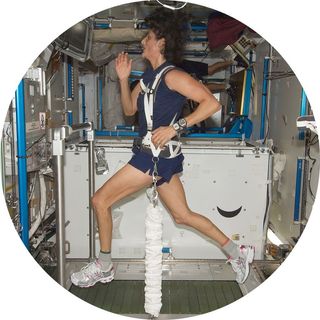
In 2007, Sunita Williams became the first person to run a marathon from space on a station treadmill in tandem with the Boston Marathon that was happening on earth. Her official completion time was 4:23:10.
Can You Sweat in Space?
Think of oil when it's poured into water; it just sits on top. That's what happens to the sweat on your body in space. Once a sweat bubble is big enough, astronauts can literally shake it off their body. All sweat bubbles are sucked into a ventilation system that collects all of the moisture from the air and recycles it. NASA’s Water Recovery System (WRS) on the ISS is made up of a water processor and a urine processor that purifies liquids. The liquid is disinfected with iodine and filtered into water that “meets the highest standards for potable use.”
All exercises are performed in the exercise room and sweaty clothes are hung there overnight so that moisture can evaporate and be recycled. The same goes for rags and towels. According to this Verge video, that same sweat will become tomorrow’s coffee, which seems a little gross at first, but is ultimately amazing because...#science.
Sex in Space
Can Astronauts Have Sex?
We hate to break it to you, but sex is not a thing in space. While NASA hasn’t confirmed or denied that crew members are banned from engaging in sexual activity (they just haven't publicly commented on the topic or, frankly, even acknowledged it), it's safe to assume it's a no-go. (There's also very little privacy since mission control monitors the astronauts throughout the day. Crew quarters are about the size of a phone booth.) If astronauts did engage in intercourse, they'd likely be breaking the code of conduct for the International Space Station crew regarding their professional relationships with each other:
"ISS Crewmembers' conduct shall be such as to maintain a harmonious and cohesive relationship among the ISS crewmembers and an appropriate level of mutual confidence and respect through an interactive, participative, and relationship-oriented approach which duly takes into account the international and multicultural nature of the crew and mission."
How to Handle Stress and Mental Health
Do Astronauts Get Stressed in Space?
Essentially, stress in space is the same as it is down here on Earth. If you’re doing a high-stress activity, like a spacewalk, your heart is going to be pumping more. In fact, astronaut Christina Koch described the start of her spacewalk when she was “looking out the airlock hatch and saw nothing but the open blackness of space” as the only moment when her heart raced. As Auñón-Chancellor explains, often times “you feel completely relaxed, like when you’re looking out the cupola down at the Earth. It’s hard not to feel relaxed doing that.”
Can You Get Sick in Space?
Headaches are most definitely still at thing in space (they can be attributed to dehydration, CO2 in the air, all of the things!) and, yes, it’s possible to get sick in space. The body has two main components to its immune system—one is innate and one is acquired. Innate means how your body treats itself, which is very much intact during spaceflight; acquired is how your body would respond to a foreign exposure.
“We're very concerned with trying to understand what's going on with the innate immune system [in space] and how the body precedes itself and what it does,” explains Dr. Fogarty. “So we have a couple of things we've been able to measure. One of them is viral shedding of viruses that most of us have since birth or since early childhood. One of them is the Epstein-Barr virus. The other one is the Herpes Simplex virus. These are very common. They often stay in your body and don't do anything. They just hang out and appear if you get challenged or stressed.”
Jessica Meir looks out the Cupola on board the International Space Station. The views of earth often provide a sense of calm for astronauts.
Are Mental Health Resources Available?
You’ve trained and trained, and then trained some more, but now you’re actually going to space and your brain needs to prepare itself for the high-risk mission you're about to endure, which is why NASA makes mental health a priority for astronauts. Prior to their spaceflight, astronauts meet with psychiatrists and psychologists whose job it is to make their transition to space as easy as possible. Once they’re in space, astronauts meet with psychologists and psychiatrists every two weeks via video chat. There are also mental health professionals available to help support their family back down on Earth.
“If you think about any human who goes through an extreme environment—like people who climb Everest or submariners who go undersea for six months at a time—you don't have access to the things you had before, whether that’s sunlight or easily being able to talk to your family," says Dr. Fogarty. "Those environments are incredibly challenging, physically and psychologically. It’s really an adaptive function of the body, which is just amazing. The body becomes pretty happy in the new environment.”



Maya Allen is the former Digital Beauty Editor at MarieClaire.com where she covered makeup, skincare, haircare, wellness, you name it! She has a 15-step skincare routine, owns over 200 red lipsticks, and enjoys testing the latest and greatest in beauty. On most weekends, you can find her at her happy place, which is her makeup vanity. There, she’s usually blasting her speakers while singing along to lyrics at the top of her lungs, and making sure her highlighter is on point.
-
 Celebrate Earth Month With Our Feel-Good Fashion Report
Celebrate Earth Month With Our Feel-Good Fashion ReportYour guide to being more sustainable in 2024.
By Anneliese Henderson Published
-
 Anne Hathaway Details the "Gross" Audition Request She Once Endured
Anne Hathaway Details the "Gross" Audition Request She Once Endured"Now we know better."
By Meghan De Maria Published
-
 The Emotional Ending of 'Baby Reindeer,' Explained
The Emotional Ending of 'Baby Reindeer,' ExplainedNetflix's latest miniseries from Richard Gadd is based on the true story of the comedian and his stalker.
By Quinci LeGardye Published
-
 37 Stress-Relieving Gifts That Will Put Anyone at Ease
37 Stress-Relieving Gifts That Will Put Anyone at EaseThe pandemic burnout is real.
By Rachel Epstein Published
-
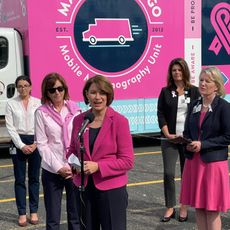 Senator Klobuchar: "Early Detection Saves Lives. It Saved Mine"
Senator Klobuchar: "Early Detection Saves Lives. It Saved Mine"Senator and breast cancer survivor Amy Klobuchar is encouraging women not to put off preventative care any longer.
By Senator Amy Klobuchar Published
-
 How Being a Plus-Size Nude Model Made Me Finally Love My Body
How Being a Plus-Size Nude Model Made Me Finally Love My BodyI'm plus size, but after I decided to pose nude for photos, I suddenly felt more body positive.
By Kelly Burch Published
-
 I'm an Egg Donor. Why Was It So Difficult for Me to Tell People That?
I'm an Egg Donor. Why Was It So Difficult for Me to Tell People That?Much like abortion, surrogacy, and IVF, becoming an egg donor was a reproductive choice that felt unfit for society’s standards of womanhood.
By Lauryn Chamberlain Published
-
 The 20 Best Probiotics to Keep Your Gut in Check
The 20 Best Probiotics to Keep Your Gut in CheckGut health = wealth.
By Julia Marzovilla Published
-
 Simone Biles Is Out of the Team Final at the Tokyo Olympics
Simone Biles Is Out of the Team Final at the Tokyo OlympicsShe withdrew from the event due to a medical issue, according to USA Gymnastics.
By Rachel Epstein Published
-
 The Truth About Thigh Gaps
The Truth About Thigh GapsWe're going to need you to stop right there.
By Kenny Thapoung Published
-
 3 Women On What It’s Like Living With An “Invisible” Condition
3 Women On What It’s Like Living With An “Invisible” ConditionDespite having no outward signs, they can be brutal on the body and the mind. Here’s how each woman deals with having illnesses others often don’t understand.
By Emily Shiffer Published

